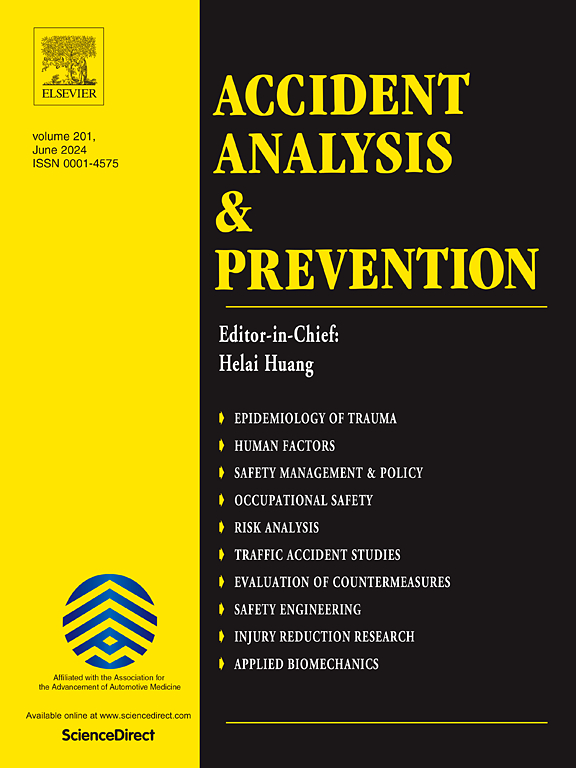Effects of time interval and request modality on driver takeover responses: Identifying the optimal time interval for two-stage warning system
IF 6.2
1区 工程技术
Q1 ERGONOMICS
引用次数: 0
Abstract
Two-stage warning system plays a critical role in guiding drivers to prepare for takeovers in conditional automated driving. However, the optimal time interval for this system, especially under different takeover request (TOR) modalities, remains unclear. A driving simulator experiment with 36 participants was conducted to investigate the effects of time interval and TOR modality of two-stage warning system on drivers’ takeover responses from a multidimensional perspective. Each participant completed takeovers with four time intervals (3 s, 5 s, 7 s, and 9 s) and three TOR modalities (visual-only, auditory-only, and auditory-visual). Drivers’ takeover performance, mental workload, situation awareness (SA), user experience, and eye movements during the takeover process were recorded. The results indicated that drivers showed faster and higher-quality takeovers as the time interval increased from 3 s to 9 s. Their ratings of satisfaction, usefulness, effectiveness, and safeness of the warning system showed the inverted U-shaped trends, with the 7 s as a turning point. The 7 s interval was also favored for drivers to regain sufficient SA while maintaining an appropriate mental workload, as evidenced by both subjective measures and eye-tracking metrics. This allowed drivers to adopt more focused visual strategies for the takeover after receiving TOR warning, thereby improving takeover performance. Additionally, the auditory-visual TOR was found to be the most effective across all measures, followed by the auditory-only TOR, and finally the visual-only TOR. No significant interaction effects between time interval and TOR modality were observed. In conclusion, regardless of TOR modality, the 7 s time interval was generally favored for young drivers with relatively limited driving experience for swift takeover responses, high takeover quality, sufficient SA, appropriate mental workload, and good satisfaction ratings. When the interval was extended to 9 s, drivers’ takeover performance improved, but with the cost of reduced satisfaction and potential shift in visual attention from driving task to non-driving-related task. These findings had implications for the design and application of appropriate time interval of two-stage warning system for Level 3 automatic vehicles.
时间间隔和请求模式对驱动接管响应的影响:确定两阶段预警系统的最佳时间间隔
在有条件自动驾驶中,两级预警系统在引导驾驶员准备接管方面起着至关重要的作用。然而,该系统的最佳时间间隔,特别是在不同的接管请求(TOR)模式下,仍然不清楚。通过驾驶模拟器实验,从多维角度研究了两阶段预警系统的时间间隔和TOR模式对驾驶员接管反应的影响。每个参与者以四个时间间隔(3秒、5秒、7秒和9秒)和三种TOR模式(仅视觉、仅听觉和视听)完成接管。记录驾驶员接管过程中的接管表现、心理负荷、态势感知(SA)、用户体验和眼球运动。结果表明,随着时间间隔从3 s增加到9 s,司机的接球速度更快,接球质量更高。他们对预警系统的满意度、实用性、有效性和安全性的评分呈倒u型趋势,以7分为转折点。主观测量和眼动追踪指标都证明,7秒的间隔也有利于司机在保持适当的精神负荷的同时恢复足够的SA。这允许司机在收到TOR警告后采取更集中的视觉策略进行接管,从而提高接管性能。此外,视听TOR被发现是所有措施中最有效的,其次是听觉TOR,最后是视觉TOR。时间间隔与TOR模式间无显著交互作用。综上所述,无论哪种TOR模式,7 s时间间隔对于驾驶经验相对有限的年轻驾驶员来说,接管反应迅速,接管质量高,SA充足,心理负荷适当,满意度较高。当间隔时间延长至9s时,驾驶员接管绩效有所提高,但代价是满意度降低,视觉注意力可能从驾驶任务转移到与驾驶无关的任务。研究结果对三级自动驾驶汽车二级预警系统的设计和应用具有一定的指导意义。
本文章由计算机程序翻译,如有差异,请以英文原文为准。
求助全文
约1分钟内获得全文
求助全文
来源期刊

Accident; analysis and prevention
Multiple-
CiteScore
11.90
自引率
16.90%
发文量
264
审稿时长
48 days
期刊介绍:
Accident Analysis & Prevention provides wide coverage of the general areas relating to accidental injury and damage, including the pre-injury and immediate post-injury phases. Published papers deal with medical, legal, economic, educational, behavioral, theoretical or empirical aspects of transportation accidents, as well as with accidents at other sites. Selected topics within the scope of the Journal may include: studies of human, environmental and vehicular factors influencing the occurrence, type and severity of accidents and injury; the design, implementation and evaluation of countermeasures; biomechanics of impact and human tolerance limits to injury; modelling and statistical analysis of accident data; policy, planning and decision-making in safety.
 求助内容:
求助内容: 应助结果提醒方式:
应助结果提醒方式:


